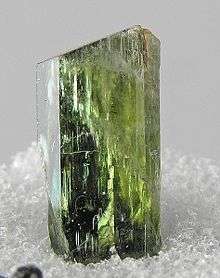Amphibole

Amphibole ( /ˈæmfᵻboʊl/) is the name of an important group of generally dark-colored, inosilicate minerals, forming prism or needlelike crystals,[1] composed of double chain SiO
4 tetrahedra, linked at the vertices and generally containing ions of iron and/or magnesium in their structures. Amphiboles can be green, black, colorless, white, yellow, blue, or brown. The International Mineralogical Association currently classifies amphiboles as a mineral supergroup, within which are two groups and several subgroups.[2]
Mineralogy
Amphiboles crystallize into two crystal systems, monoclinic and orthorhombic. In chemical composition and general characteristics they are similar to the pyroxenes. The chief differences from pyroxenes are that (i) amphiboles contain essential hydroxyl (OH) or halogen (F, Cl) and (ii) the basic structure is a double chain of tetrahedra (as opposed to the single chain structure of pyroxene). Most apparent, in hand specimens, is that amphiboles form oblique cleavage planes (at around 120 degrees), whereas pyroxenes have cleavage angles of approximately 90 degrees. Amphiboles are also specifically less dense than the corresponding pyroxenes. In optical characteristics, many amphiboles are distinguished by their stronger pleochroism and by the smaller angle of extinction (Z angle c) on the plane of symmetry. Amphiboles are the primary constituent of amphibolites.
In rocks
Amphiboles are minerals of either igneous or metamorphic origin; in the former case occurring as constituents (hornblende) of igneous rocks, such as granite, diorite, andesite and others. Calcium is sometimes a constituent of naturally occurring amphiboles. Those of metamorphic origin include examples such as those developed in limestones by contact metamorphism (tremolite) and those formed by the alteration of other ferromagnesian minerals (hornblende). Pseudomorphs of amphibole after pyroxene are known as uralite.
History and etymology
The name amphibole (Ancient Greek ἀμφίβολος - amphíbolos meaning 'ambiguous') was used by René Just Haüy to include tremolite, actinolite, tourmaline and hornblende. The group was so named by Haüy in allusion to the protean variety, in composition and appearance, assumed by its minerals. This term has since been applied to the whole group. Numerous sub-species and varieties are distinguished, the more important of which are tabulated below in two series. The formulae of each will be seen to be built on the general double-chain silicate formula RSi4O11.[3]
Four of the amphibole minerals are among the minerals commonly called asbestos. These are: anthophyllite, riebeckite, cummingtonite/grunerite series, and actinolite/tremolite series. The cummingtonite/grunerite series is often termed amosite or brown asbestos; riebeckite is known as crocidolite or blue asbestos. These are generally called amphibole asbestos.[4]
Mineral species
Chemical formula
Orthorhombic series
- Anthophyllite, (Mg,Fe)7Si8O22(OH)2
- Holmquistite, Li2Mg3Al2Si8O22(OH)2
- Ferrogedrite, Fe2+5Al4Si6O22(OH)2
Monoclinic series
- Tremolite, Ca2Mg5Si8O22(OH)2
- Actinolite, Ca2(Mg,Fe)5Si8O22(OH)2
- Cummingtonite, Fe2Mg5Si8O22(OH)2
- Grunerite, Fe7Si8O22(OH)2
- Hornblende, (K,Na)0-1(Ca,Na,Fe,Mg)2(Mg,Fe,Al)5(Al,Si)8O22(OH)2
- Glaucophane, Na2(Mg,Fe)3Al2Si8O22(OH)2
- Riebeckite (or Crocidolite), Na2Fe2+3Fe3+2Si8O22(OH)2
- Arfvedsonite, Na3Fe2+4Fe3+Si8O22(OH)2
- Richterite, Na2Ca(Mg,Fe)5Si8O22(OH)2
- Pargasite, NaCa2Mg3Fe2+Si6Al3O22(OH)2
- Winchite, (CaNa)Mg4(Al,Fe3+)Si8O22(OH)2
- Edenite, NaCa2Mg5(Si7Al)O22(OH)2
Descriptions
On account of the wide variations in chemical composition, the different members vary considerably in properties and general appearance.
Anthophyllite occurs as brownish, fibrous or lamellar masses with hornblende in mica-schist at Kongsberg in Norway and some other localities. An aluminous related species is known as gedrite and a deep green Russian variety containing little iron as kupfferite.[3]
Hornblende is an important constituent of many igneous rocks. It is also an important constituent of amphibolites formed by metamorphism of basalt.
Actinolite is an important and common member of the monoclinic series, forming radiating groups of acicular crystals of a bright green or greyish-green color. It occurs frequently as a constituent of greenschists. The name (from Greek ἀκτίς, ἀκτῖνος/aktís, aktînos, a 'ray' and λίθος/líthos, a 'stone') is a translation of the old German word Strahlstein (radiated stone).[3]
Glaucophane, crocidolite, riebeckite and arfvedsonite form a somewhat special group of alkali-amphiboles. The first two are blue fibrous minerals, with glaucophane occurring in blueschists and crocidolite (blue asbestos) in ironstone formations, both resulting from dynamo-metamorphic processes. The latter two are dark green minerals, which occur as original constituents of igneous rocks rich in sodium, such as nepheline-syenite and phonolite.[3]
Pargasite is a rare magnesium-rich amphibole with essential sodium, usually found in ultramafic rocks. For instance, it occurs in uncommon mantle xenoliths, carried up by kimberlite. It is hard, dense, black and usually idiomorphic, with a red-brown pleochroism in petrographic thin section.
See also
- List of minerals
- Classification of minerals - Silicates
- http://media-2.web.britannica.com/eb-media/53/2653-004-DB6D5422.gif
Notes
- ↑ "Amphibole". Dictionary of Geology. Retrieved 2013-01-21.
- ↑ Mindat, Amphibole Supergroup
- 1 2 3 4
 One or more of the preceding sentences incorporates text from a publication now in the public domain: Spencer, Leonard James (1911). "Amphibole". In Chisholm, Hugh. Encyclopædia Britannica. 1 (11th ed.). Cambridge University Press. pp. 883–884.
One or more of the preceding sentences incorporates text from a publication now in the public domain: Spencer, Leonard James (1911). "Amphibole". In Chisholm, Hugh. Encyclopædia Britannica. 1 (11th ed.). Cambridge University Press. pp. 883–884. - ↑ US Geological Survey, Asbestos, accessed 20 July 2015.
References
- C. Michael Hogan. 2010. Calcium. eds. A.Jorgensen, C. Cleveland. Encyclopedia of Earth. National Council for Science and the Environment.
- Cornelius S. Hurlbut and Cornelis Klein. 1985. Manual of Mineralogy, 20th ed., John Wiley and Sons, New York ISBN 0-471-80580-7